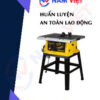Occupational Safety Training for Reciprocating Saw Operation
99,000 ₫
Note: The price above is calculated per person and may fluctuate depending on the number of participants in the course and market conditions. For more accurate pricing support, please refer to the price list or contact our consulting staff directly.
Occupational safety is an important issue when operating a jigsaw and must be addressed promptly to ensure the health and safety of workers and enhance the reputation of businesses here. The Occupational Safety Training course is one of the effective solutions to raise awareness of how to prevent workplace accidents for workers operating a jigsaw.
Table of Contents
Toggle1. Overview of the Sabre Saw Machine
a. What is a Sabre Saw?
The sabre saw, also known as a reciprocating saw (sabre saw machine), is a handheld power tool used to cut materials such as wood, metal, plastic, and many others. It is designed with a long, thin blade to cut through materials of varying thicknesses.
The sabre saw blade is replaceable to suit different cutting applications. Sabre saws are commonly used in construction, electrical work, metalworking, mechanical projects, and crafts. This allows users to cut and create precise shapes or holes in materials more efficiently and easily compared to other cutting tools.
Sabre saws come in various models with different features and power to meet the specific needs of users.

b. Operating Principle of the Sabre Saw
The operating principle of a sabre saw is quite simple. The machine uses a saw blade, often with teeth at the front, and works as follows:
- Power source: The sabre saw uses electricity to drive a motor that moves the blade.
- Blade movement: The motor moves the blade up and down rapidly, creating a “pulsing” or “cutting” motion. The blade may have teeth or be smooth, depending on the type of work.
- Pressure and cutting direction: The user applies pressure to the saw on the target material and guides the blade along the desired cutting path. Pressure and direction are controlled by the user to ensure precise and safe cuts.
- Cutting: As the blade moves, it cuts through the material along the path directed by the user. The powerful motor and rapid blade movement ensure accurate and efficient cutting.
Sabre saws are often used for special cutting tasks or in confined spaces where other cutting tools cannot be used. It is essential that users follow safety measures and manufacturer instructions to avoid accidents and injuries.

c. Industries that Use Sabre Saws
Sabre saws are widely used in various industries and applications to cut different materials. Some main industries include:
- Construction: Used to cut wood, metal, and other building materials for components like windows, doors, timber, pipes, and more.
- Wood manufacturing: Used in furniture production and other wood products to cut and shape specific parts.
- Metalworking: Used to cut and shape metals such as steel, aluminum, and copper in manufacturing machinery, metal products, and other applications.
- Food processing: Can be used to cut food items like meat, fish, or wood in food and processing industries.
- Crafts and arts: Artisans and craftsmen use sabre saws to cut and shape components for artistic and craft products.
- Shipbuilding: Used to cut and shape ship components such as steel plates and structural elements.
- Paper and packaging: Can be used to cut sheets of paper or cardboard in paper and packaging production.
- Toys and crafts manufacturing: Used to cut and shape components for toys and craft items.
2. Overview of Occupational Safety Training for Sabre Saw Operation
a. What is Occupational Safety Training?
- Occupational safety training for sabre saw operation provides workers with awareness and skills to prevent workplace accidents. Workers directly operating sabre saws fall under Group 3.
- The training helps workers identify and avoid hazards, reducing the risk of accidents during work.
REGISTER FOR OCCUPATIONAL SAFETY TRAINING
b. Training Duration
Initial Safety Training Duration:
- Total training time is at least 24 hours, including testing.
- 8 hours of theory on policies, laws on occupational safety and hygiene
- 8 hours of theory on basic safety and hygiene knowledge
- 4 hours of theory on specialized training content
- 2 hours of practical training on specialized content
- 2 hours of theory test at the end of the course
The training center will schedule sessions depending on workers’ availability, typically over 6 sessions across 3 days if the company allows continuous training.
Periodic Safety Training:
- Before the occupational safety card expires, workers must attend periodic occupational safety training, with a duration of at least 50% of the initial training.
Explanation: Total periodic safety training time is at least 12 hours, including testing. After completing the course and passing the test, workers are reissued or have their safety cards extended.
c. Training Course Content
| No. | TRAINING CONTENT | TRAINING DURATION (HOURS) | |||
| Total | Including | ||||
| Theory | Practice | Test | |||
| I | Policies and laws on occupational safety and hygiene | 8 | 8 | 0 | 0 |
| 1 | Overview of legal documents and regulations on occupational safety and hygiene. | 6 | 6 | ||
| 2 | Standards and technical regulations for occupational safety and hygiene. | 1 | 1 | ||
| 3 | Specific regulations by state management agencies regarding safety, hygiene, and compliance for machinery, equipment, and materials. | 1 | 1 | ||
| II | Basic knowledge of occupational safety and hygiene | 8 | 8 | 0 | 0 |
| 1 | Basic knowledge of hazards and harmful factors at the workplace. | 4 | 4 | ||
| 2 | Methods to improve working conditions. | 1 | 1 | ||
| 3 | Safety culture in production and business. | 1 | 1 | ||
| 4 | Rights and obligations of employers and employees; safety policies; role of safety officers. | 1 | 1 | ||
| 5 | Safety rules, signage, use of safety equipment and PPE, first aid skills, occupational disease prevention. | 1 | 1 | ||
| III | Specialized training content | 6 | 4 | 2 | 0 |
| Comprehensive knowledge of machinery, equipment, hazardous substances, risk assessment, safe work procedures. | 6 | 4 | 2 | ||
| IV | Final training assessment | 2 | 2 | 0 | 0 |
| Total | 24 | 22 | 2 | ||
See more training content for all 6 groups.
d. Occupational Safety Card
Upon completing the safety training course and passing the test, workers will receive a safety card (commonly called a Group 3 safety certificate).
The Group 3 card displays the worker’s name, date of birth, job, work environment, training duration, red seal, and signature confirming completion.
According to Clause 2 of Article 24, Decree 44/2016/ND-CP, there are two cases:
- If the employer and employee have a labor contract, the employer must sign and stamp the safety card after the employee completes training and passes the test.
- If the worker is freelance or temporary without a labor contract, the training unit must sign and stamp the safety card after the worker completes training and passes the test.

3. Hazards When Operating a Sabre Saw
Operating a sabre saw can pose many hazards to workers if safety measures are not followed and the saw is not used carefully. Below are some common hazards when using a sabre saw:
- Injuries from the blade: The sabre saw blade moves quickly and can cause serious injuries if safety rules are not followed. The risk of cuts or injuries to hands and fingers is very high.
- Dust and material fragments: Cutting with a sabre saw can generate dust and material fragments. Inhaling dust or contact with flying fragments can cause health issues, including lung inflammation and eye injuries.
- Accidents from detached blades: If the blade is loose or improperly attached, it can fall off and cause accidents.
- Electric shock: As an electrical device, a sabre saw always carries the risk of electric shock, especially if exposed to water or improperly maintained.
- Unsafe working conditions at heights or on unstable surfaces.

4. Occupational Accident Control Measures When Operating a Sabre Saw
To control accidents when operating a sabre saw, workers must follow the safety measures and rules below:
- Training and guidance: Ensure workers are trained and guided on how to use the sabre saw safely. Training includes how to operate the machine, safety rules, and emergency procedures.
- Personal protective equipment: Workers must wear protective gear such as safety glasses, helmets, protective clothing, and gloves to protect eyes, head, and hands.
- Check the sabre saw: Before starting work, workers should inspect the saw to ensure it operates properly and has no issues. Ensure the blade is securely attached and not loose.
- Use quality blades: Select a blade suitable for the material to be cut and ensure it is of high quality to avoid breaking during operation.
- Maintain a safe distance: Always keep a safe distance between hands and the blade as well as other workers near the cutting area.
- Avoid working when fatigued: Do not operate the saw when tired or stressed, as this increases the risk of accidents.
- Protect eyes and respiratory system: Use safety glasses to protect against dust and flying fragments. Ensure proper ventilation and use a respirator if necessary.
- Safe blade replacement: When changing the blade, ensure the saw is disconnected from power. Perform this carefully to avoid injury.
- Maintenance and cleaning: Maintain the sabre saw regularly and clean it after each use to ensure safe and effective operation.
- Be aware of potential hazards: Always be alert to the working environment, especially if there is a risk of collision or being too close to others while using the saw.
- Periodic inspection of the sabre saw to detect safety issues such as wear, mechanical failure, or defects, thereby reducing the risk of occupational accidents.
5. Benefits of Occupational Safety Training
An Toàn Nam Việt provides the following benefits to businesses after completing occupational safety training courses according to Decree 44/2016/ND-CP on occupational safety and hygiene:
- Workers can recognize potential hazards and take preventive measures to avoid accidents.
- Businesses can establish risk prevention measures in production, operation, and maintenance processes.
- Minimizes costs related to workplace safety incidents.
- Ensures uninterrupted production, increasing labor productivity and product quality.
- Compliance with labor safety laws, avoiding legal risks.
- Enhances professionalism and credibility, boosting the company’s brand.
Nam Viet’s training courses are a proactive solution against external hazards, helping individuals avoid injuries or more serious risks.
REGISTER FOR OCCUPATIONAL SAFETY TRAINING SERVICE
6. Customer Feedback After Training
An Toàn Nam Việt has many years of experience supporting enterprises across Vietnam, especially in the southern provinces. This responsibility is invaluable, which is why our occupational safety training has become increasingly professional. Positive feedback and suggestions from clients have been key to our growth. Below are some testimonials from our clients.
See more customer interviews after using the service from An Toàn Nam Việt
7. An Toàn Nam Việt’s Occupational Safety Training Capabilities
An Toàn Nam Việt is a reputable and quality occupational safety training center in Vietnam, conducting training continuously at factories, production facilities, and construction sites nationwide (all 63 provinces).
REGISTER FOR OCCUPATIONAL SAFETY TRAINING SERVICE
Occupational Safety Training License
- An Toàn Nam Việt has been inspected and certified by the Safety Department of the Ministry of Labor – Invalids and Social Affairs to meet conditions for occupational safety and hygiene training, further strengthening our training capabilities.

Training Materials and Lectures
- Before being used in training courses, all occupational safety materials are reviewed to ensure accuracy and effectiveness.
- Teaching methods are standardized according to An Toàn Nam Việt’s guidelines, developed by occupational safety experts to maximize learning outcomes.
Facilities
- Classroom conditions are carefully controlled to enhance teaching performance and knowledge absorption.
- Our training facilities are spacious and meet standards for lighting, equipment, and classroom environment.
8. Nationwide Reputable Safety Training Center
At An Toàn Nam Việt, occupational safety training is our top priority. We aim to equip workers with knowledge to protect themselves, contributing to national development.
To ensure training effectiveness, we meticulously prepare tools, teaching materials, and classroom conditions.
Our trainers are experts with years of experience, even conducting research on identifying hazards across industries and prevention methods.
Lessons are practical and engaging, helping workers comfortably absorb knowledge, fully aligned with Decree 44/2016/ND-CP.
This enables workers to apply safety measures effectively in their work.
Our training center is proud to provide professional and reputable occupational safety training with advantages:
- Competitive training fees while ensuring quality.
- Flexible training schedules according to company production needs.
- Quick and compliant certification procedures.
- Experienced trainers with long industry expertise.
- Classroom conditions optimized for effective learning.
- Lessons tailored to occupational safety in enterprises.
- An Toàn Nam Việt provides precise and professional support for clients.

9. Additional Occupational Safety Training Resources
- Occupational Safety Training Materials
- Safety Materials for Operating a Sabre Saw (Sword Saw Machine)
- Occupational Safety Training Test Questions
- Multiple Choice Test for Sabre Saw Safety
- Training Slides for Sabre Saw Safety Operation
1 review for Occupational Safety Training for Reciprocating Saw Operation
No comments yet















phanminhhang341
Đơn vị chuyên nghiệp về huấn luyện an toàn lao động